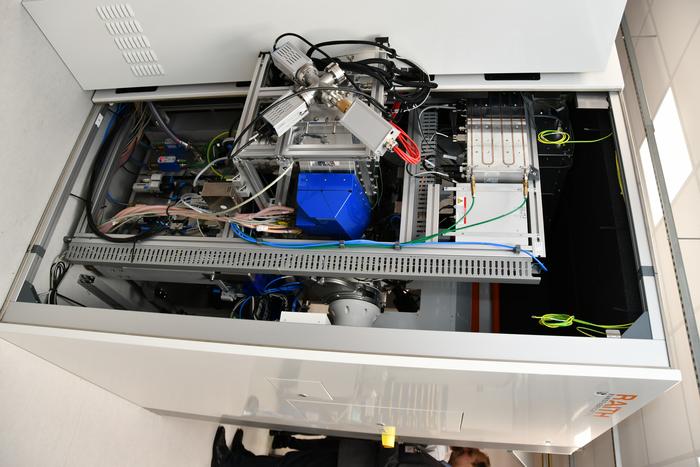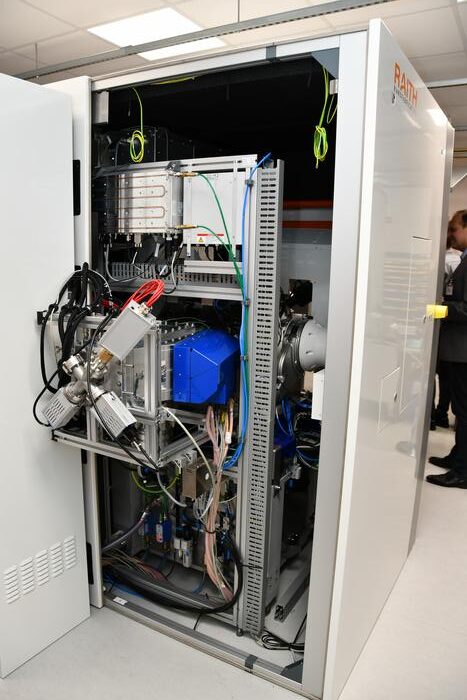The Luxembourg Institute of Science and Technology (LIST) announced the commercial launch of magSIMS (a Magnetic Sector Secondary Ion Mass Spectrometry system), an award-winning nano-imaging instrument, over an event, which took place on 22 February 2024 at the institute’s Belvaux campus.

Credit: LIST
The Luxembourg Institute of Science and Technology (LIST) announced the commercial launch of magSIMS (a Magnetic Sector Secondary Ion Mass Spectrometry system), an award-winning nano-imaging instrument, over an event, which took place on 22 February 2024 at the institute’s Belvaux campus.
The occasion also marked the opening of a joint lab and the signing of a licensing contract between LIST and Raith, a prominent German manufacturer specializing in precision technology for nanofabrication, to undertake the commercialization of magSIMS.
The magSIMS is a breakthrough instrument, developed by LIST researchers, which has the ability to not only view objects in the minutest details, but also to produce chemical composition information simultaneously.
Discovering magSIMS and its various applications across multiple disciplines
Understanding the structure and chemical composition at the nanometre scale is crucial across various fields, including batteries, electronics, biology, or functional materials. This level of analysis allows for detailed examination, which for instance is required when designing new electronic devices, developing new photovoltaic materials or studying sub-cellular structures in biology.
In materials science, the magSIMS can be widely used for nano-characterization. It enables the analysis of complex 3D architectures. In photovoltaics, it helps in understanding the composition of thin films crucial for the performance and longevity of solar cells. In life sciences, it allows high-resolution chemical analysis of biological samples. And beyond materials and life sciences, magSIMS finds applications in soil science, geology, and even cultural heritage analysis.
A success story made-in-Luxembourg more than a decade in the making
The history of the technology behind magSIMS goes back a decade. “Our initial exploration focused on the feasibility of obtaining chemical information with highest sensitivity at the nano level,” says Dr Tom Wirtz, Head of Unit, Scientific Instrumentation and Process Technology at LIST. “This led us to consider ion and electron microscopy combined with mass spectrometry as a key aspect.”
In conventional electron microscopy, one can observe minuscule entities at the nano level using specialized instruments. “The challenge then was to introduce an additional dimension to this capability, which involves incorporating chemical information,” he added. The objective was not only to visualize the appearance of a sample but also to discern its composition.
This led to the development of a mass spectrometer: a technology that allows scientists to identify specific elements based on their distinct masses. The resulting nanoimaging instrument became the first microscope able to view samples in tiny details while simultaneously determining their chemical composition. The research and the technology won national and international accolades.
From lab to the market: partnership between LIST and Raith
Through various collaborations over the years, LIST’s technology has been adopted by multiple companies, leading to the installation of the instrument on numerous microscopes worldwide. However, large scale manufacturing was still limited. “While interest from the industry was evident, the production of the instrument remained with us at LIST as the demand from individual companies wasn’t large enough,” says Wirtz.
Now, however, the signing of the licensing and partnership agreement with Raith, a prominent German manufacturer specializing in precision technology for nanofabrication, has opened up the potential for the instrument to be manufactured by the company, thereby expanding its accessibility and adoption on a broader scale.
“Raith has actively collaborated with LIST over the past two years to identify and define advancements in the field of nano-analytics that are mutually beneficial,” says Wirtz. “Today, they intend to form a global partnership focusing not only on the establishment of a joint laboratory and common research and development projects, but also on manufacturing the instrument as a product for broader distribution and on providing worldwide maintenance of these instrument after they are installed.”
Talking about the instrument and the partnership with Raith, Dr Damien Lenoble, Director of the materials department at LIST, said: “The partnership and subsequent commercialization of magSIMS represent significant achievements for LIST and Luxembourg, as the technology will be now deployed worldwide thanks to our trusted partner Raith. This perfectly illustrates LIST’s core mission of leveraging early-stage research to develop unique capabilities and enhance the maturity of proprietary technologies over time. The impending changes in technologies, particularly those driving transitions in sectors such as energy, consumer electronics and mobility, make magSIMS particularly attractive as a versatile instrumentation tool. We are especially pleased to have consistently supported this research-based innovation until it reached market readiness for widespread adoption.”





